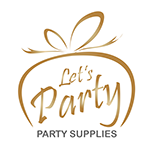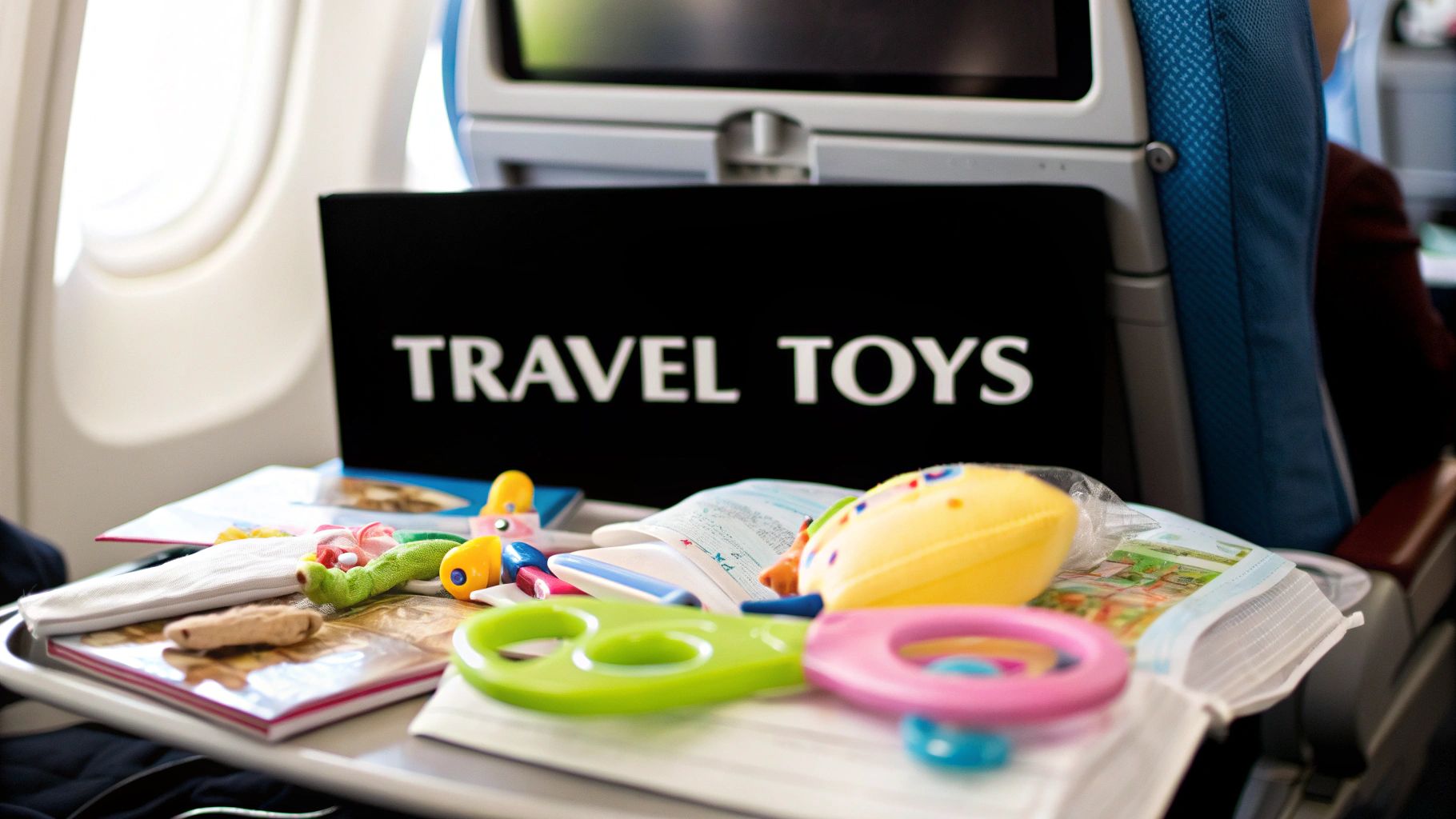
Let’s be honest, traveling with a baby can feel like you’re just waiting for the next meltdown. But it doesn't have to be that way. The secret? Having the right travel toys for infants tucked away in your diaper bag. A few well-chosen toys can be the difference between a stressful flight and a surprisingly peaceful journey.
Why Smart Travel Toys Are a Parent's Best Friend
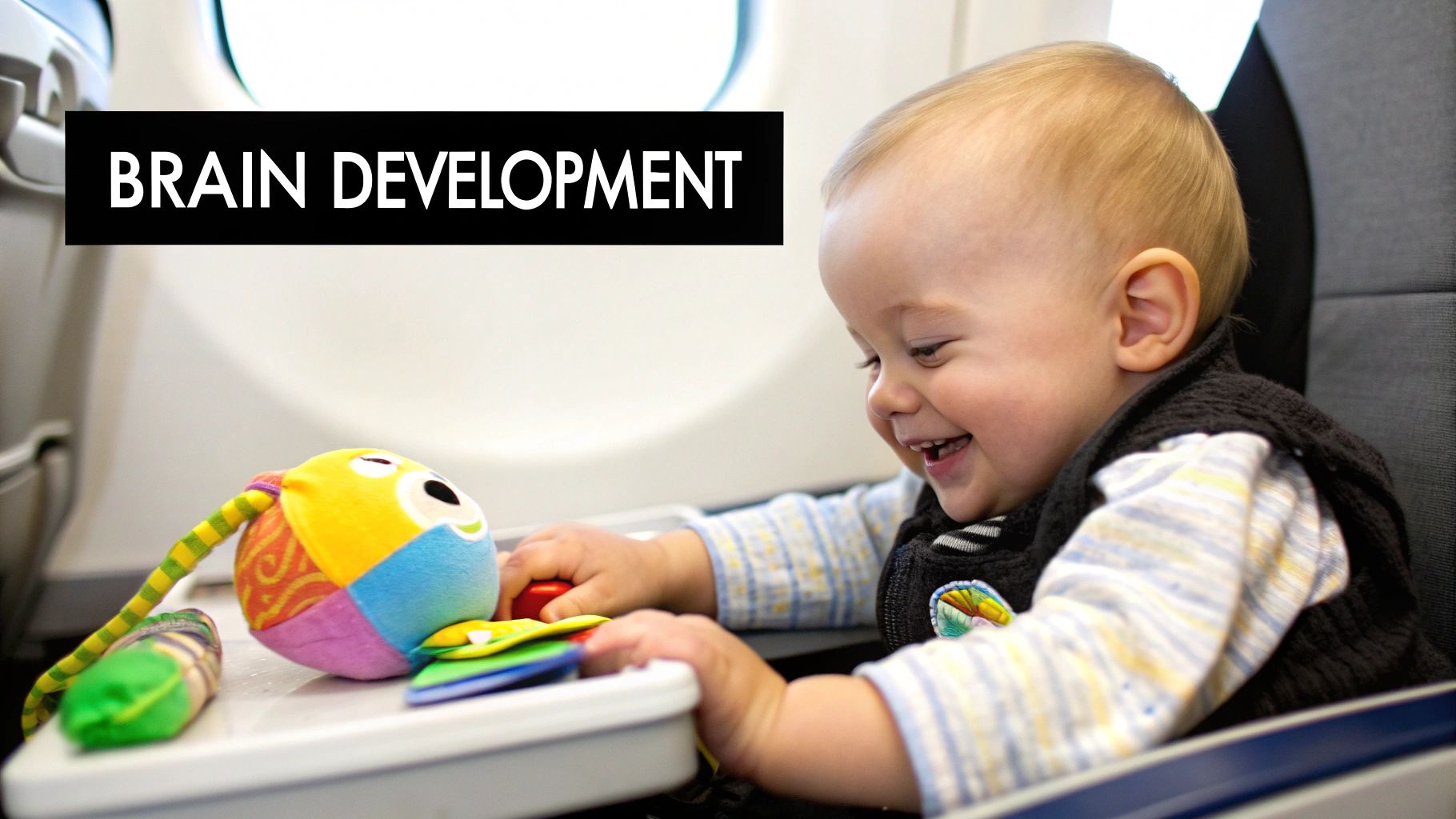
Keeping an infant happy while strapped into a car seat or confined to an airplane row is no small feat. This is where a good travel toy goes from being a nice-to-have to an absolute essential. They’re not just distractions; they are genuinely helpful tools for engaging your baby's senses, encouraging development, and keeping them calm.
A fantastic travel toy does more than just keep tiny hands busy. It can be a piece of familiar comfort in a new, strange place, which works wonders for soothing anxiety. Think of these toys as your secret weapon for surviving a long layover or an unexpected traffic jam.
More Than Just a Distraction
The growing appreciation for purpose-built travel toys is easy to see in the market. The global baby toys market was valued at around USD 6.21 billion in 2024 and is projected to climb to USD 9.19 billion by 2033. A big reason for this growth is that modern parents are always on the move and need portable, compact toys that fit their lifestyle. You can read more about the baby toys market trends to see how things are shifting.
The best travel toys for infants serve multiple purposes. They should be lightweight enough not to weigh down your carry-on, durable enough to withstand being dropped, and easy to clean with a quick wipe.
Key Features of a Great Travel Toy
When you're picking out toys for a trip, think beyond just what looks fun. The most effective options usually have a few things in common that make them perfect for the road.
- Multi-Sensory Engagement: Toys with different textures, crinkly sounds, or bold, high-contrast patterns are brilliant at holding a baby's attention for longer.
- Portability and Compact Design: It has to be easy to pack. Even better, look for toys that can clip onto a stroller, car seat, or diaper bag so they don't get lost.
- Safety and Hygiene: Always check that the materials are non-toxic and BPA-free. Toys made from silicone or hard plastic are great because you can sanitize them in a snap.
Matching Toys to Your Infant's Travel Needs
Picking the right travel toys for your baby isn't about just grabbing the smallest things you can find. Let's be honest, we've all been there. But the toys that really work are the ones that sync up with where your baby is at developmentally. Think of it as turning travel time into a sneaky opportunity for them to learn and explore.
What mesmerizes a two-month-old is going to be old news for a ten-month-old who's busy trying to figure out how the world works. Nailing this match is the secret to a happier, more engaged baby, whether you're on a long flight or just waiting for a table at a restaurant.
For the Tiniest Travelers: 0-3 Months
In these early days, your baby's world is a beautiful, fuzzy blur of shapes and sounds. Their vision is just coming into focus, which is why high-contrast patterns are so captivating. They’re also just starting to follow objects with their eyes and respond to gentle noises.
The best toys for this age are simple, lightweight, and easy for you to hold and show them. The goal is gentle stimulation, not a sensory overload.
- High-Contrast Soft Books: Forget the complex stories for now. Books with simple black-and-white patterns or bold, primary colors on soft fabric pages are perfect for their developing eyes.
- Lightweight Rattles: A rattle with a soft, gentle sound is fantastic for helping them practice tracking sounds. Plus, it's a great first step toward them eventually trying to grasp it themselves.
- Plush Toys with Different Textures: A small, soft toy with crinkly ears or a silky ribbon gives them a simple, safe way to start exploring the sense of touch.
For Curious Explorers: 4-8 Months
Welcome to the "grab and mouth" stage! Everything goes directly into their mouth. This is a crucial time for developing hand-eye coordination and exploring textures, especially with teething in full swing. Toys for this age group need to be tough, safe to chew on, and interesting enough to hold their attention.
You're looking for items that can stand up to some serious drool and are engaging enough to be pulled out of the bag multiple times during a trip.
The most successful travel toys for this age group are multitasking masters. They need to be durable, a breeze to wipe clean, and interesting enough for your baby to rediscover over and over again.
This is where sensory toys really shine, offering different textures and sounds that keep little hands and minds busy.
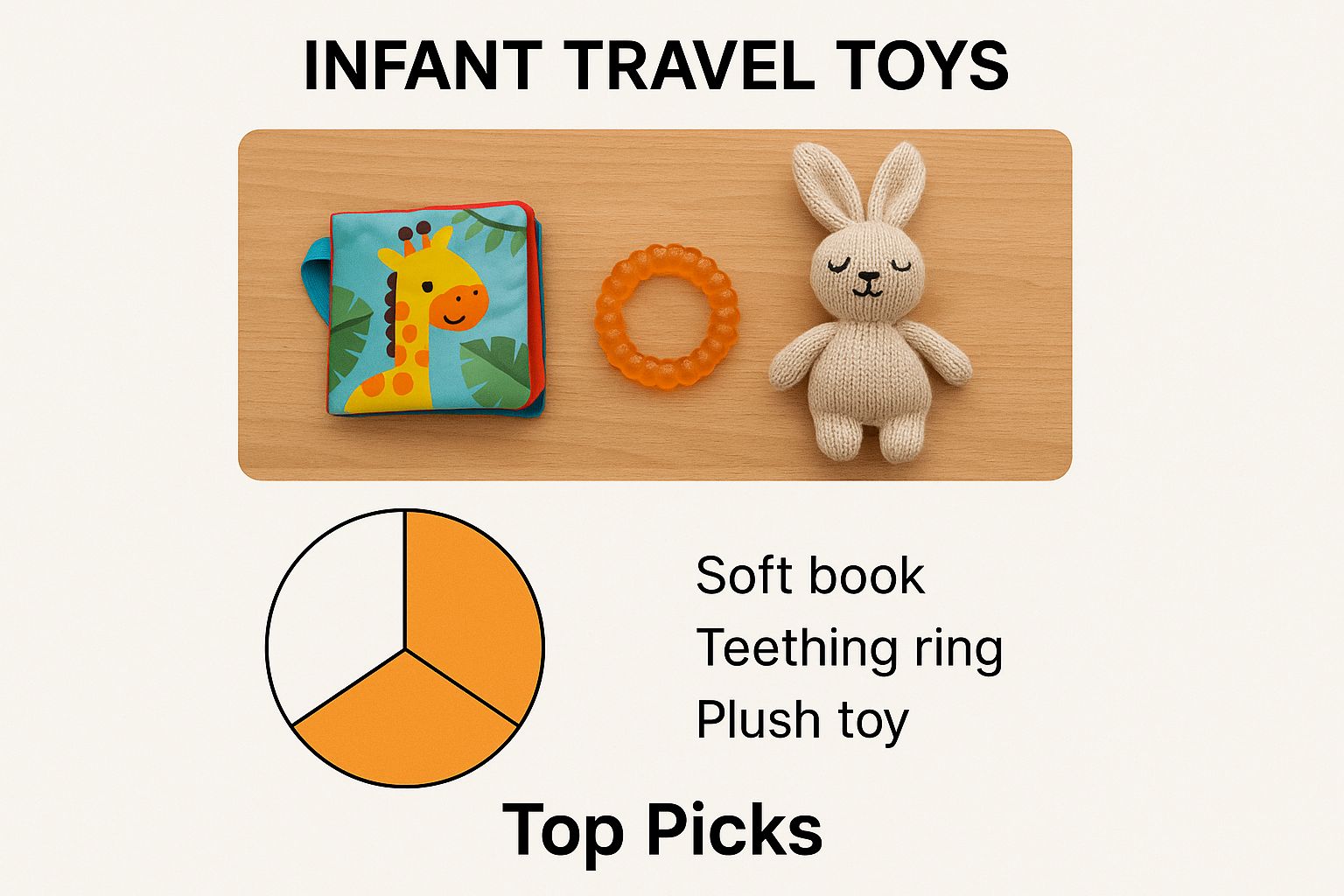
As you can see, things like teething rings and crinkly books are travel gold. They soothe sore gums while providing that satisfying sound and feel babies love.
For Little Movers and Shakers: 9-12 Months
Your baby is now officially a little problem-solver. They’re working hard on their fine motor skills, starting to understand cause-and-effect ("If I drop this, Mom picks it up!"), and becoming much more interactive. The best toys for this age challenge these new skills and can keep them happily occupied on a plane's tray table.
This is a huge category in the toy world, with parents spending around $3.7 billion in 2024 on developmental toys like these. You can dig deeper into the stats on the booming infants and toddlers toy market if you're curious. For travel, you want something a bit more complex but still portable.
- Durable Board Books: Look for books with fun flaps to lift or different textures to feel. You'd be surprised how long this can hold their attention.
- Simple Stacking Toys: A few colorful rings on a single post are perfect. They're compact and fantastic for practicing coordination without a million pieces to lose under the seat.
- Chunky Puzzles: A basic wooden puzzle with just one or two big, easy-to-grab pieces is a fantastic travel companion for budding problem-solvers.
To make it even easier, here's a quick cheat sheet to help you match the perfect toy to your baby's age and stage.
Age-Appropriate Travel Toy Selector
| Age Range | Key Developmental Focus | Ideal Travel Toy Examples |
|---|---|---|
| 0-3 Months | Sensory development, visual tracking | High-contrast flashcards or soft books, lightweight rattles, soft toys with different textures. |
| 4-8 Months | Grasping, hand-eye coordination, teething relief | Silicone teethers, crinkle books, soft activity balls, O-ball toys. |
| 9-12 Months | Fine motor skills, problem-solving, cause-and-effect | Stacking cups or rings, chunky puzzles (1-3 pieces), board books with flaps, Indestructibles books. |
Remember, you know your baby best. These are just starting points! The goal is to find a few versatile items that will keep them happy and engaged, making your journey that much smoother.
Your Strategic Toy Packing Plan
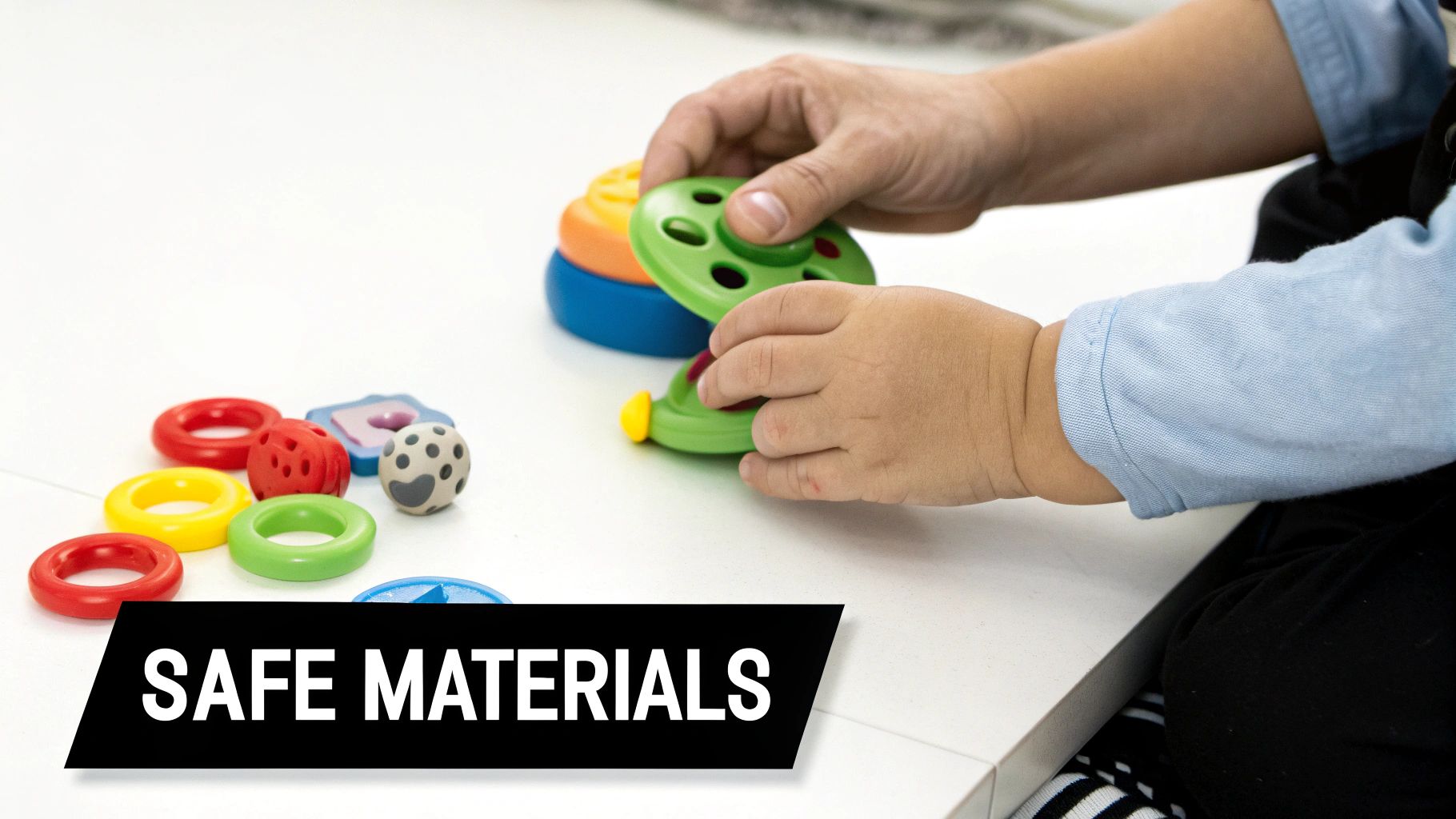
It’s so tempting to just grab a handful of small toys, toss them in a bag, and call it a day. But I’ve learned from experience that a little bit of strategy can save your sanity. Packing with a purpose means you’ll have the perfect toy ready at just the right moment, without feeling like you’re lugging around a separate suitcase just for entertainment.
My number one rule for smart packing? The One Accessible Bag principle. Every single essential travel toy for infants needs to live in one, easy-to-reach spot. For most of us, this is the diaper bag or a dedicated carry-on tote. This completely avoids that frantic, mid-flight scramble through overhead luggage while your baby’s patience is rapidly disappearing. Trust me, making infant travel easier with a great diaper bag is the foundation of a smooth trip.
The Game-Changing Toy Rotation Technique
If there's one pro-tip I can share for long journeys, it's the toy rotation. Instead of overwhelming your baby with all their options at once, you introduce them one at a time. This simple trick keeps everything feeling fresh and new, making a small collection of toys seem almost endless.
Here’s how I make it work:
- Create the Surprise: I keep most of the toys tucked away and out of sight. The second fussiness starts to creep in, I bring out a "new" toy they haven't seen for a bit.
- Hit the Reset Button: Each new item completely resets their attention span. This can buy you anywhere from five to twenty precious minutes of calm. It’s a lifesaver.
- Less Is So Much More: This method really proves you don't need a mountain of stuff. All it takes is a few well-timed reveals to keep them happy.
I swear by this on long-haul flights. Pulling out a new crinkle toy three hours into an eight-hour flight can feel like a magical gift to a bored infant. It has completely changed the mood for us more times than I can count.
This approach doesn't just save valuable packing space; it makes each toy feel more special in the moment. You'll find this same smart-packing philosophy applied to grown-up travel, too—check out this detailed https://findtoptrends.com/blog/spain-packing-list-the-fitnessista/ for a great example of packing versatile essentials.
Practical Tips for Smarter Packing
Beyond the rotation, a few other practical choices can make a huge difference. I always prioritize toys that can pull double or even triple duty. A simple set of stacking cups, for instance, is a superstar. They can be stacked, nested, used as bath toys, or even become makeshift shovels for scooping sand at the beach.
Another game-changer? Toy leashes. These simple straps attach a toy directly to the car seat, stroller, or high chair. This puts an end to the dreaded game of "I-drop-it-you-pick-it-up" on a grimy airport floor. It saves you from constantly having to retrieve and sanitize fallen toys. Packing smarter is really just about thinking ahead to those small, annoying challenges and having an easy solution ready to go.
What to Look for: Your Non-Negotiable Toy Safety Checklist
At home, you've got a baby-proofed, controlled environment. But on the road? Not so much. Your baby’s toys are going to see it all—airport floors, grubby restaurant tables, you name it. That’s why toy safety shifts from a background concern to an absolute must-do before you pack a single thing.
Before any toy earns a spot in your carry-on, it needs a quick but thorough once-over. This isn't about being over-the-top; it's just smart parenting. Keeping your little one safe is just as fundamental as, say, learning childbirth tips for women with low pain tolerance before the big day arrives. A few simple checks can give you incredible peace of mind.
It’s no surprise that the baby and toddler toy market is massive—valued at USD 24.5 billion in 2024. A huge chunk of that growth comes from parents like us looking for safe, portable toys that actually do something good for our kids' development. If you're interested in the data behind this, you can discover more insights about toy market trends on cognitivemarketresearch.com.
First Things First: The Choking Hazard Check
This is the big one. An infant’s airway is tiny, and anything that can fit through a toilet paper tube is generally considered a red flag. It’s a classic test for a reason.
Give every potential travel toy a quick physical inspection. I always give a firm tug on any buttons, sewn-on eyes, or other small attachments to make sure they’re not going anywhere. It’s best to just leave behind anything with long strings, ribbons, or tiny parts that look like they could snap off with a bit of determined chewing.
My Go-To Rule: Can any part of this toy be squished down small enough to fit into my baby's mouth? If the answer is yes, it stays home. This simple gut check has helped me veto more than a few questionable toys over the years.
Materials and Cleanliness on the Go
Let's be real: every single travel toy will end up in your infant's mouth. So, what they’re made of is non-negotiable. I only pack toys that are clearly labeled BPA-free, phthalate-free, and made from non-toxic, food-grade materials. You can't go wrong with high-quality silicone or natural rubber.
Hygiene on the road is a whole different ballgame. You won’t always have a convenient place to scrub toys down.
- Look for Smooth Surfaces: Hard plastic and silicone toys are a parent's best friend. They wipe clean in seconds, unlike plush toys that seem to soak up every germ they meet.
- Wipes are Your Secret Weapon: I never leave home without a pack of baby-safe, non-toxic sanitizing wipes. A dropped teether can be made safe again in a flash.
- Simple is Better: The fewer nooks and crannies a toy has, the less space there is for grime to hide. It's that simple.
Creative Entertainment Beyond the Toy Bag
Let’s be honest, even the most thoughtfully curated bag of travel toys for infants has its limits. There’s a universal moment, usually halfway through a long-haul flight, when your baby looks you dead in the eye and declares they are done with every single thing you packed.
This is where you get creative. The good news? Your travel environment is a goldmine of fascinating, screen-free distractions just waiting to be discovered.
You don't need a bottomless bag to keep your baby happy. Sometimes the most captivating things are the most unexpected. An empty plastic water bottle (make sure that lid is screwed on tight) becomes an amazing shaker. The crinkly sound of an in-flight magazine can provide a solid few minutes of sensory fun. Just keep a close eye on it so they don't eat the paper!
Your Most Important Toy is You
While random objects are fantastic, don't forget about your most powerful tool: yourself. You are, and always will be, your baby's absolute favorite thing to play with. Simple, classic games take up zero packing space and work wonders when a baby is getting fussy in a tight spot.
These are my go-to's for a reason:
- Peek-a-boo: It's a classic for a reason. You can use your hands, a spare burp cloth, or even the tray table for a quick game of surprise.
- Finger Plays: Little songs and rhymes like "The Itsy Bitsy Spider" or "Pat-a-Cake" are perfect. They involve gentle touch and familiar rhythms that can be incredibly soothing.
- "I See" Games: Simply point things out. "I see the blinking light on the wing." "Look at the swirly pattern on the seat!" A flight attendant's colorful scarf can be endlessly fascinating to a little one.
The real secret to happy baby travel isn’t about how many toys you can cram into a carry-on. It's about being present and engaging with your little one. Your voice, your smile, and your attention are the most powerful tools in your arsenal.
Tapping Into Travel Wellness
Remember, a calm and happy parent almost always leads to a calmer, happier baby. Taking care of your own stress levels is a huge piece of the puzzle. For more ideas on this, our guide on travel wellness must-haves has some great, practical advice for staying centered while you're on the move.
When you feel good, it's so much easier to tap into that playful, creative energy your baby needs from you. If you can shift your mindset, the journey itself—with all its new sounds, sights, and faces—becomes the ultimate travel toy.
Still Have Questions About Infant Travel Toys?
Let’s be honest, even the most meticulously planned packing list can leave you second-guessing. When you're packing for a baby, a million little "what ifs" pop into your head. It's completely normal. Let's walk through some of the most common questions I hear from parents about travel toys, so you can feel confident and get that suitcase closed.
Getting these details sorted turns packing from a major source of stress into just another item on your to-do list. You'll know exactly what’s worth the precious space in your bag and what you can safely leave behind.
How Many Toys Do I Actually Need to Pack?
This is the big one, isn't it? We all have that fear of being under-prepared, but we also dread lugging around a diaper bag that weighs a ton. A good rule of thumb I've learned over the years is to aim for one toy for every hour of active travel, but with a hard cap of about 5-7 versatile toys in total. The secret isn't volume; it's variety.
Try to cover a few different sensory bases with your picks. Think about bringing:
- Something to chew on: A good silicone teether is non-negotiable for soothing those sore gums on the go.
- Something that makes a gentle sound: A soft crinkle book or a small rattle can be a lifesaver, providing just enough noise to be interesting without annoying everyone in row 23.
- Something visually engaging: High-contrast cards or a brightly colored grasping toy are perfect for capturing their attention as their eyesight develops.
- Something for little hands: A simple set of stacking rings or a toy that encourages grasping helps them work on those budding motor skills.
The real trick isn’t about how many toys you bring, but how you introduce them. Keep most of them hidden away and pull out a “new” one every so often. This rotation strategy makes a small collection feel like a bottomless bag of fun.
This approach keeps them entertained for so much longer and saves your carry-on from becoming a black hole of baby gear.
What Kinds of Toys Should I Avoid on a Plane?
Knowing what to pack is only half the battle; knowing what to leave at home is just as important. Some toys are just not built for the tight, shared space of an airplane cabin. For your own sanity (and the sanity of those around you), please leave these behind.
Steer clear of anything with loud, repetitive electronic sounds or flashy lights. They can be incredibly overstimulating for your baby and downright disruptive for fellow passengers. Messy items are another hard no—think play-doh, slime, or anything that involves paint or tiny pieces that can get lost forever under the seat.
Also, be practical. Super heavy or bulky toys just aren't worth the carry-on real estate. And one last pro-tip: think twice before packing that one-of-a-kind, irreplaceable "favorite" toy. The chances of it getting dropped, left behind, or lost in transit are surprisingly high, and a lost lovey is a vacation meltdown you just don't need.
How Do I Keep Everything Clean?
Let's face it, toys will end up on the airport floor, the rental car seat, and probably under a restaurant table. Hygiene is a huge concern, so the key is to choose toys that are ridiculously easy to clean.
Your best bet is materials like food-grade silicone or hard plastic. You can wipe these non-porous surfaces down in a flash, and they don’t harbor germs like fabric toys can. I always keep a small pack of baby-safe sanitizing wipes handy for those inevitable tumbles. For a deeper clean back at the hotel, a quick scrub in the sink with a bit of soap and hot water is all you need.
Can I Just Use Everyday Stuff as Toys?
Absolutely! And you totally should. Sometimes the best "toys" are the things you already have with you. Babies are fascinated by the novelty of everyday objects, and using them can be a lifesaver when you’re in a pinch.
With a little creativity and supervision, so many common items can become a source of entertainment.
- An empty plastic water bottle with the cap screwed on tight makes a fantastic rattle.
- A clean set of plastic measuring spoons is great for grasping, exploring, and clanking together.
- Even the in-flight safety card or a crinkly magazine can provide minutes of sensory fun.
The number one priority is always safety. Make sure any object you hand your baby is clean, has no sharp edges, and is too large to be a choking hazard. Honestly, it's often your interaction with the object that makes it so engaging and fun for them.
At FindTopTrends, we curate the best products to make your life easier, including top-rated essentials for traveling with your little one. Explore our collections to find everything you need for your next family adventure.
Discover trending baby and travel essentials at FindTopTrends now!



